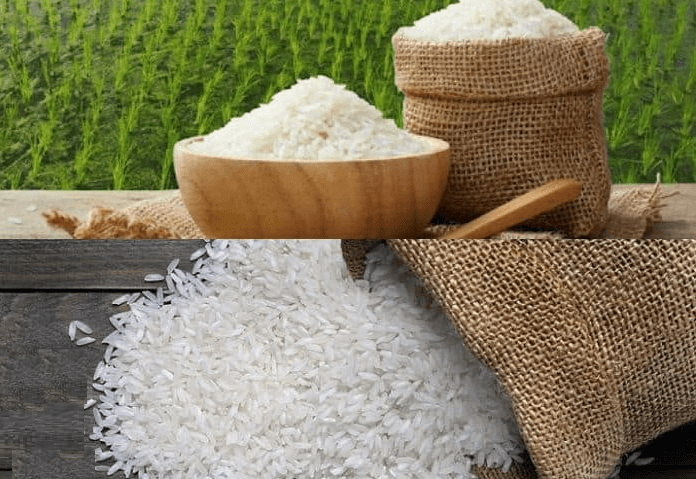
Global rice supply has been disrupted by the limited export of rice that India restricts – non-basmati white rice, rice and rice – all have decreased significantly in the same period. This has created difficulties for importing countries in Southeast Asia, South Asia and sub-Saharan Africa, forcing them to seek alternative sources in the context of when other major rice exporting countries, including Vietnam and Thailand, were also affected by the production of rice by El Nino. < p> Global rice production and El Niño < p> Global rice production has not increased, partly due to the impact of El Nino on drought in key rice-producing countries in Asia. The US Department of Agriculture (USDA) estimates global rice production in the 2023/2024 marketing year is about 513.7 million tons – a slight increase from 513.5 million tons the previous year. Meanwhile, exports in 2024 are predicted to be as predicted in 2023.
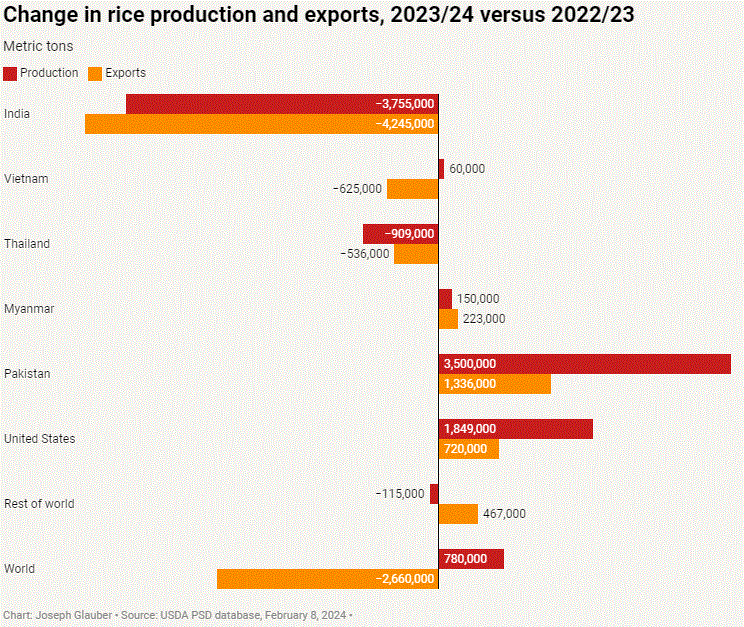
Percentage change in world rice production and exports in 2023/24 compared to the previous year.
Sharp decline in India’s rice exports
In the context of this already uncertain global supply, India’s export restrictions have added tension to the market. Although exports continued in the first half of 2023 to important markets in West Africa, such as Senegal, this export activity became negligible from July 2023. From August to November 2023, India only exported 28,500 tons of rice, down 95% from the previous year. The ban on non-basmati white rice also similarly reduced export volumes. From August to November 2023, white non-basmati rice exports reached a total of about 154,000 tons, down 93%.
Exports of non-basmati rice that were not affected by the export restrictions in July 2023 increased by 39% in August 2023 as exporters switched products to make up for the loss. To address this issue, in August 2023 India imposed an additional 20% duty on non-basmati rice. As a result, in September, the export of non-basmati rice decreased by 69%.
From August to November 2023, India’s rice exports reached a total of 3.7 million tons, down 46% from the previous year. Only basmati rice exports increased by 12%, increasing from August to November 2023 compared to 2022.
As a result, India’s rice exports have declined in most major markets . . The areas with an increase (North America, Northern Europe, South Africa) are the areas where basmati rice dominates.
But most areas where major rice imports from India are restricted from exporting have seen decreases of 50% or more from the previous year, especially in the sub-Saharan Africa region. For example, India’s rice exports to West Africa decreased by about 1.2 million tons or 54%, while India’s rice exports to countries in East and Central Africa decreased by 58% and 80% respectively.
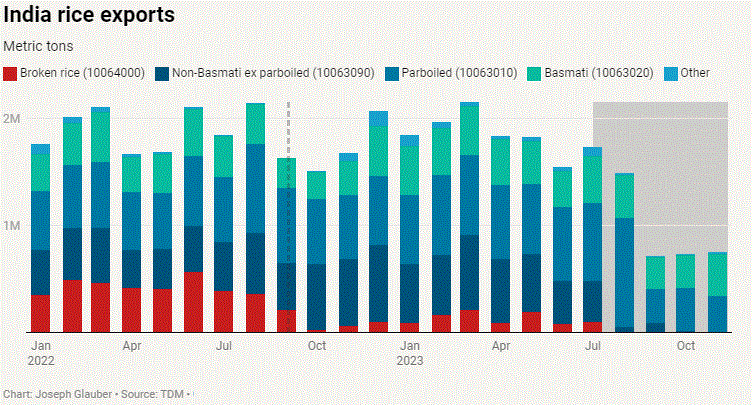
Decline in India’s rice exports.
Sharp rise in global rice prices
Import restrictions in India have pushed rice prices up sharply worldwide. In key exporting countries, the price of Vietnamese rice has increased by 46% in 2023, while Thai rice has increased by 42% and Indian rice has increased by 34%.
The reference white rice price of Thailand (5% broken) has increased by 22% since India’s ban on non-basmati white rice exports took effect in July 2023.
In importing countries, prices have also risen sharply.
The price of rice in Indonesia has reached record highs. The average price of medium-quality rice in Jakarta on February 24, 2024 was 14,860 Rp / kg; while premium rice was 18,000 rupiahs (1.15 USD) / kg, an increase of 20% compared to the same period last year. Premium quality rice in some places even reached 21,000 Rp / kg. These prices have exceeded government-regulated ceiling prices.
In the market >, rice prices in January 2024 also soared despite the increase in reserves. Accordingly, the average wholesale price of milled rice in January 2024 was 46.60 peso / kg, up 1.7% from 45.83 peso / kg in December. Compared to the same period last year, that price is 32.7% higher, with the average price in January 2023 being only 35.11 pesos per kg. Similarly, the average wholesale price of well-polished rice increased by 1.5% to 49.96 P / kg and is 28.6% higher than the 38.28 P / kg in January 2023.
Bangladesh is also in a situation where domestic rice prices are continuously increasing despite recent high domestic rice harvests, forcing them to reduce rice import tariffs from 63% to 15% in early 2024 and may import 500,000 tons of rice in the 2023/24 marketing year to lower domestic rice prices.
In Africa, rice prices have even increased even more. Rice prices in Nigeria have increased by 98.47% from January 2023 to January 2024, with the most significant increase experienced by people in the capital, Abuja. The average price of 1 kg of rice is 1,021.79 naira, an increase of 98.47% compared to the 514.83 naira in the same period last year and an 11.31% increase over the 917.93 naira in December 2023. The highest price was recorded in the capital. Abuja, 1,350 naira / kg.
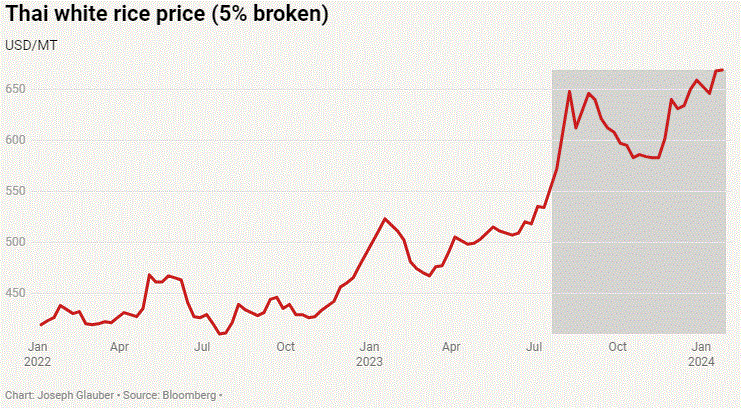
5% broken Thai rice price.
Importing countries have to b> find alternative rice sources
India is an important rice supply source worldwide, especially for countries in Africa (this South Asian country accounts for about 40% of global rice trade in 2022-23). Madagascar’s rice imports from all sources reached an average of 425,000 tons in 2023, a 44% decrease from 2022 (about 80% of the country’s rice imports come from India in the form of non-basmati rice) and as of August 2023, most of the country’s rice imports are from Pakistan. For Kenya, in the first 7 months of 2023, rice imports decreased to almost zero after India restricted exports. Senegal also reduced rice imports from India by 50% while increasing imports from Pakistan.
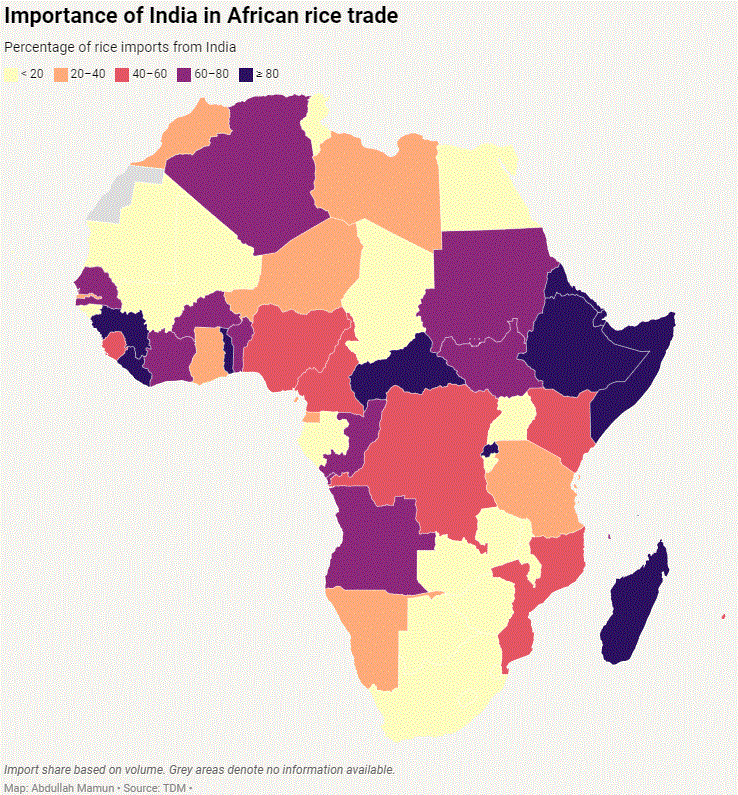
India’s important role in rice trade in Africa.
With these developments, the important question now is how long will India’s export restrictions last? Recently, India has extended the 20% duty on rice imports indefinitely (expected until March 31, 2024) to prevent any potential price increase on the domestic market before the general election.Indifia’s rice market will therefore remain at least a complex time longer.
Reference: Ifpri





































